A digital workplace is an integrated technology framework that centralizes your organization’s applications, data, and collaboration tools. It enables you to seamlessly work, communicate, and collaborate across departments and geographies.
Picture an ecosystem where your employees can access data, collaborate on projects, and communicate with clients under one virtual roof.
Adopting a digital workplace can drastically transform the way your organization operates. It’s not just about efficiency; it’s about fostering innovation, attracting top talent, and offering value to your clients.
A digital workplace can be the catalyst that propels your business to new heights- and right now is the perfect time to try it.
In 2020, a survey by Harvard Business Review revealed that 78% of C-Suite executives believe connecting and empowering frontline employees is critical to their success. Yet a year later, Meta found that 94% of the C Suite admit that they traditionally prioritize office and desk-based technologies.
That means your competitors know digital workplaces are important- but they may not yet act on that belief. This presents an opportunity for the bold.
But building a digital workplace can require heavy investment in digital adoption, and the process isn’t without challenges.
This article will explore everything you need to know about the digital workplace. We’re going through a brief history of how digital workplaces have evolved and the key elements of a successful digital workplace. Then we’ll provide some practical strategies for creating your digital workplace.
A (very brief) history of the transition toward digital workplaces
Let’s take a quick walk down memory lane.
In the late 1970s and early 1980s, personal computers began entering the office. This was the first step in digitizing the workplace.
Fast forward to the 1990s, and the internet revolutionized how information was shared and accessed, this period marked the beginning of a more connected world.
The 2000s saw the rise of cloud computing, making data and applications accessible from anywhere.
The last decade has been about integrating these technologies into a cohesive environment. The emergence of mobile devices and advancements in artificial intelligence and machine learning has accelerated the transition to digital workplaces.
Today, you are poised to leverage this powerful transformation to create a more agile, innovative, and successful organization.
Components of a digital workplace
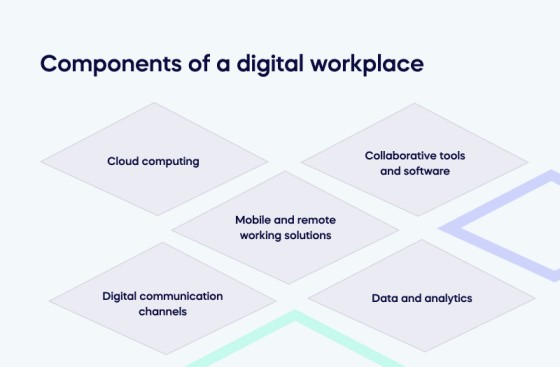
These five categories of different technologies and tools form the backbone of a modern digital workplace.
Some suites of tools fulfill multiple purposes at once, making them efficient choices.
Regardless, if you want to build a digital workplace, you should have a solution in mind for each of the following components:
Cloud computing
Cloud computing allows you to store data and applications on remote servers, which can be accessed via the Internet.
This means that your team can work from anywhere, at any time, and on any device.
It’s not just about accessibility; cloud computing also brings scalability and cost savings. You can quickly scale resources up or down according to your business needs without the hassle of maintaining physical servers.
Collaborative tools and software
Imagine being able to work on a project with colleagues across the globe as if they were sitting right next to you.
Collaborative tools make this possible.
They enable real-time collaboration on documents, task management, and project planning. This enhances productivity and ensures everyone is on the same page, regardless of where they are.
Mobile and remote working solutions
The ability to work remotely is a game-changer.
Mobile solutions are integral to providing your team with the flexibility they need. This includes access to corporate resources via smartphones and tablets.
When selecting mobile solutions, it’s vital to consider security, integration with other tools, and user experience.
Remember, a happy and well-equipped team is an efficient one.
Digital communication channels
Effective communication is the lifeblood of any organization.
With teams often spread across different locations, digital communication channels are indispensable. This includes email, instant messaging, video conferencing, and social networks.
Digital communication channels can help to foster an environment of open communication.
They also help maintain the human element, especially if your team is distributed.
Data and analytics
Last but certainly not least, data and analytics are crucial components of a digital workplace.
With the sheer amount of data generated by various tools, you need a way to make sense of it all.
Analytics tools can help you gather insights, understand trends, and make data-driven decisions.
Whether tracking employee performance, understanding customer behavior, or optimizing processes, data analytics can provide the information you need to make informed decisions and steer your business in the right direction.
Five benefits of implementing a digital workplace
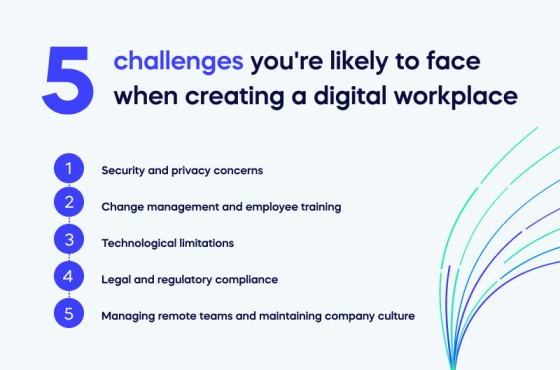
If you’re still unsure whether a digital workplace could work for you or need to assemble a strong business case to kick the project off, this list of benefits is a great place to start.
Here are the five most compelling benefits of a digital workplace:
1. Increased productivity
When you incorporate a digital workplace into your business, one of the first benefits you’ll notice is a significant boost in productivity.
With access to data and tools at their fingertips, your team can accomplish tasks more efficiently. Automating repetitive tasks frees up time, allowing employees to focus on more high-value activities.
Moreover, the ability to easily collaborate and share information can streamline workflows, resulting in quicker completion of projects.
2. Improved collaboration and communication
Your team members might be spread across different cities or continents in today’s globalized world.
Digital workplaces are essential in bridging these geographical gaps.
Employees can collaborate seamlessly, regardless of location, through collaborative tools and digital communication channels. This speeds up decision-making and ensures that everyone is aligned and informed.
3. Enhanced employee experience and engagement
A well-implemented digital workplace can lead to happier and more engaged employees.
The flexibility of remote work, user-friendly tools, and an open communication culture can significantly enhance the employee experience.
A recent study commissioned by SalesForce revealed that employees dissatisfied with their workplace tech are more than twice as likely to leave their job in the next year, less than half as likely to recommend their employer, and less likely to feel productive.
Moreover, when employees see that you’re investing in tools and technologies that make their lives easier, they are more likely to be engaged and committed to your organization’s goals.
4. Scalability and flexibility
As your business evolves, so do your needs.
One of the beauties of a digital workplace is its inherent scalability and flexibility. Cloud computing, for instance, allows you to scale your resources according to demand easily.
Moreover, with a digital framework, you can quickly adapt to market changes, implement new tools, or venture into new markets with minimal friction.
5. Cost savings and efficiency
Finally, implementing a digital workplace can lead to significant cost savings.
You can lower overhead costs by reducing the need for physical office space and resources. Furthermore, the efficiency gained through automation and streamlined processes means that your team can accomplish more in less time.
With more effective resource allocation, you can achieve better results without necessarily increasing your expenses.
Five challenges you’re likely to face when creating a digital workplace
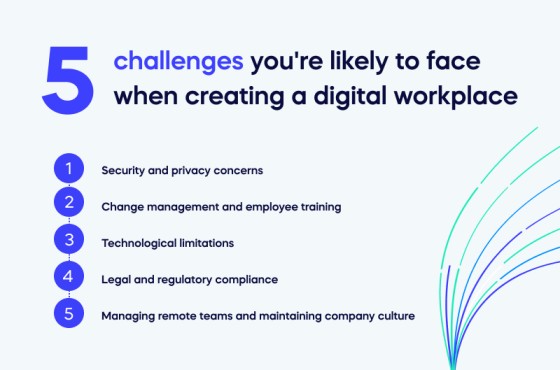
On the other side of the coin, there are several challenges you’ll need to overcome before your digital workplace is properly effective.
Some of these challenges need to be addressed from the offset, so take a minute to familiarize yourself with them now:
1. Security and privacy concerns
Security and privacy should be on your mind as you transition to a digital workplace.
With data and applications accessible online, there’s an inherent risk of breaches and unauthorized access. Implementing robust security measures, such as encryption, two-factor authentication, and regular security audits, is imperative.
Additionally, educating your employees on best practices for data security is crucial in safeguarding sensitive information.
2. Change management and employee training
Change can be daunting, especially when it involves altering how your team works.
It’s vital to have a well-thought-out change management plan in place. This includes transparent communication about the changes, providing training, and soliciting feedback.
Ensuring that your team is comfortable and adept at using new tools is essential in reaping the benefits of a digital workplace.
3. Technological limitations
Not all technologies are created equal, and sometimes the tools you adopt might have limitations that hinder your workflow.
It’s important to evaluate tools and technologies thoroughly before implementation.
Also, keeping an eye on technological advancements and being open to switching to more efficient solutions when they become available is key to maintaining an agile digital workplace.
4. Legal and regulatory compliance
With a digital workplace often comes a global workforce.
This introduces an array of legal and regulatory compliance challenges. Countries have varying data protection regulations, labor laws, and more.
It’s essential to be well-versed in these regulations and ensure your digital workplace complies. This might involve working with legal experts and regularly reviewing your compliance status.
5. Managing remote teams and maintaining company culture
While remote working offers flexibility, it also brings challenges in terms of team management and company culture. According to Gartner, 76% of HR leaders feel that hybrid work has challenged employees’ connection to organizational culture
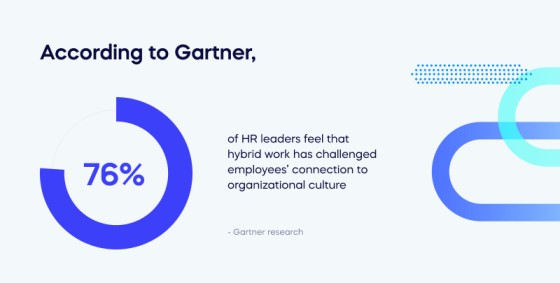
Building and maintaining a cohesive company culture can be challenging without physical interactions. It’s important to foster an open communication environment and create opportunities for social interaction among team members.
Additionally, adapting your management style to suit a remote workforce better and employing tools that enable effective remote team management is essential.
Practical strategies for an effective transition to a digital workplace
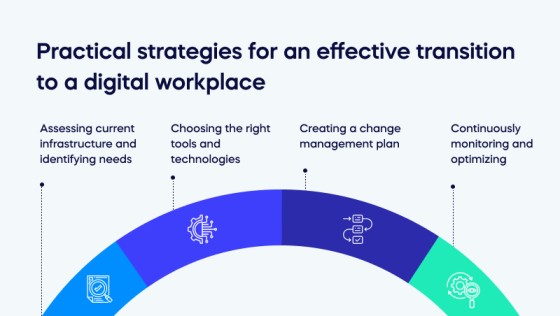
Check out these useful tips and strategies before taking the plunge and building your digital workplace.
They’ll shine a light on a few things you may not have considered- and ironing these details out now will save you time and headaches.
By following these strategies, you’ll be well on your way to establishing a digital workplace that empowers your team, streamlines operations, and positions your business for growth and success.
Assessing current infrastructure and identifying needs
Before diving into the transformation, taking stock of where you currently stand is crucial.
Assess your existing infrastructure, tools, and workflows. Engage with different departments to understand their specific needs and challenges.
This assessment will give you a clearer picture of the gaps that must be addressed and help set priorities for your transition to a digital workplace.
Choosing the right tools and technologies
Armed with the information from your assessment, you can now focus on selecting the tools and technologies that align with your business goals and needs.
Keep in mind that there’s no one-size-fits-all solution. Evaluate different options based on their features, scalability, security, and integration capabilities.
Engage with vendors and seek expert advice if needed. It’s important that the tools you choose address immediate needs and have the flexibility to adapt as your business evolves.
Creating a change management plan
Change can be unsettling for employees, and managing this transition effectively is essential to avoid disruptions and ensure buy-in from your team.
Develop a change management plan that outlines the steps involved in the transition, the expected outcomes, and how it will affect different departments.
Communicate transparently with your team and involve them in the process. This will help to alleviate concerns and ensure a smoother transition.
Continuously monitoring and optimizing
Transitioning to a digital workplace is not a one-off project but an ongoing process.
Once you’ve implemented new tools and workflows, monitoring their performance and impact is important. Gather data on productivity, employee engagement, and other relevant metrics. Use this data to identify areas where further optimization is needed.
Also, be open to adapting and adopting new technologies as they emerge to ensure that your digital workplace continues to be agile and efficient.
Future trends in the digital workplace
The digital workplace is far from a finished product; it’s an evolving ecosystem.
Future trends include a greater emphasis on hybrid workforce models, where physical and digital workplaces seamlessly blend.
The Internet of Things (IoT) will likely become an integral part of the digital workplace, with connected devices streamlining various processes. Additionally, expect to see virtual and augmented reality advancements for enhanced collaboration.
Artificial intelligence will become even more sophisticated, providing insights and automation like never before.
Being prepared and adaptable is crucial in leveraging these future technologies to elevate your business further.
But the most important thing to remember when thinking about the digital workplace of the future? It’s this:
The future is now.
Digital workplaces are here to stay, and if yours isn’t up to scratch, you lose out on a considerable number of benefits and risk losing good employees to competitors who have been investing in their digital workplace for months or years.
If you want to keep up, let alone remain competitive, you must start building your digital workplace today.


